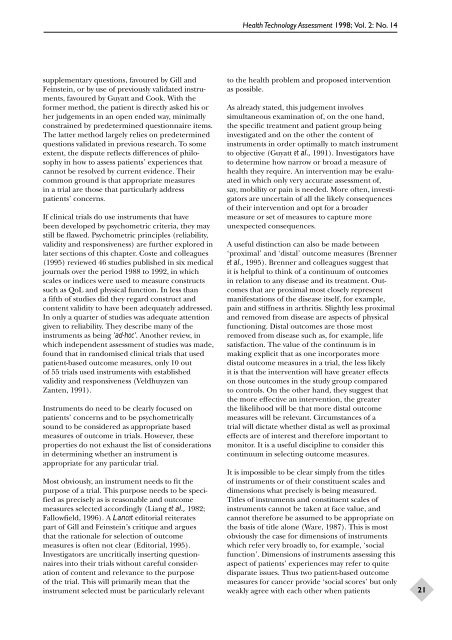Evaluating Patient-Based Outcome Measures - NIHR Health ...
Evaluating Patient-Based Outcome Measures - NIHR Health ...
Evaluating Patient-Based Outcome Measures - NIHR Health ...
Create successful ePaper yourself
Turn your PDF publications into a flip-book with our unique Google optimized e-Paper software.
supplementary questions, favoured by Gill and<br />
Feinstein, or by use of previously validated instruments,<br />
favoured by Guyatt and Cook. With the<br />
former method, the patient is directly asked his or<br />
her judgements in an open ended way, minimally<br />
constrained by predetermined questionnaire items.<br />
The latter method largely relies on predetermined<br />
questions validated in previous research. To some<br />
extent, the dispute reflects differences of philosophy<br />
in how to assess patients’ experiences that<br />
cannot be resolved by current evidence. Their<br />
common ground is that appropriate measures<br />
in a trial are those that particularly address<br />
patients’ concerns.<br />
If clinical trials do use instruments that have<br />
been developed by psychometric criteria, they may<br />
still be flawed. Psychometric principles (reliability,<br />
validity and responsiveness) are further explored in<br />
later sections of this chapter. Coste and colleagues<br />
(1995) reviewed 46 studies published in six medical<br />
journals over the period 1988 to 1992, in which<br />
scales or indices were used to measure constructs<br />
such as QoL and physical function. In less than<br />
a fifth of studies did they regard construct and<br />
content validity to have been adequately addressed.<br />
In only a quarter of studies was adequate attention<br />
given to reliability. They describe many of the<br />
instruments as being ‘ad-hoc’. Another review, in<br />
which independent assessment of studies was made,<br />
found that in randomised clinical trials that used<br />
patient-based outcome measures, only 10 out<br />
of 55 trials used instruments with established<br />
validity and responsiveness (Veldhuyzen van<br />
Zanten, 1991).<br />
Instruments do need to be clearly focused on<br />
patients’ concerns and to be psychometrically<br />
sound to be considered as appropriate based<br />
measures of outcome in trials. However, these<br />
properties do not exhaust the list of considerations<br />
in determining whether an instrument is<br />
appropriate for any particular trial.<br />
Most obviously, an instrument needs to fit the<br />
purpose of a trial. This purpose needs to be specified<br />
as precisely as is reasonable and outcome<br />
measures selected accordingly (Liang et al., 1982;<br />
Fallowfield, 1996). A Lancet editorial reiterates<br />
part of Gill and Feinstein’s critique and argues<br />
that the rationale for selection of outcome<br />
measures is often not clear (Editorial, 1995).<br />
Investigators are uncritically inserting questionnaires<br />
into their trials without careful consideration<br />
of content and relevance to the purpose<br />
of the trial. This will primarily mean that the<br />
instrument selected must be particularly relevant<br />
<strong>Health</strong> Technology Assessment 1998; Vol. 2: No. 14<br />
to the health problem and proposed intervention<br />
as possible.<br />
As already stated, this judgement involves<br />
simultaneous examination of, on the one hand,<br />
the specific treatment and patient group being<br />
investigated and on the other the content of<br />
instruments in order optimally to match instrument<br />
to objective (Guyatt et al., 1991). Investigators have<br />
to determine how narrow or broad a measure of<br />
health they require. An intervention may be evaluated<br />
in which only very accurate assessment of,<br />
say, mobility or pain is needed. More often, investigators<br />
are uncertain of all the likely consequences<br />
of their intervention and opt for a broader<br />
measure or set of measures to capture more<br />
unexpected consequences.<br />
A useful distinction can also be made between<br />
‘proximal’ and ‘distal’ outcome measures (Brenner<br />
et al., 1995). Brenner and colleagues suggest that<br />
it is helpful to think of a continuum of outcomes<br />
in relation to any disease and its treatment. <strong>Outcome</strong>s<br />
that are proximal most closely represent<br />
manifestations of the disease itself, for example,<br />
pain and stiffness in arthritis. Slightly less proximal<br />
and removed from disease are aspects of physical<br />
functioning. Distal outcomes are those most<br />
removed from disease such as, for example, life<br />
satisfaction. The value of the continuum is in<br />
making explicit that as one incorporates more<br />
distal outcome measures in a trial, the less likely<br />
it is that the intervention will have greater effects<br />
on those outcomes in the study group compared<br />
to controls. On the other hand, they suggest that<br />
the more effective an intervention, the greater<br />
the likelihood will be that more distal outcome<br />
measures will be relevant. Circumstances of a<br />
trial will dictate whether distal as well as proximal<br />
effects are of interest and therefore important to<br />
monitor. It is a useful discipline to consider this<br />
continuum in selecting outcome measures.<br />
It is impossible to be clear simply from the titles<br />
of instruments or of their constituent scales and<br />
dimensions what precisely is being measured.<br />
Titles of instruments and constituent scales of<br />
instruments cannot be taken at face value, and<br />
cannot therefore be assumed to be appropriate on<br />
the basis of title alone (Ware, 1987). This is most<br />
obviously the case for dimensions of instruments<br />
which refer very broadly to, for example, ‘social<br />
function’. Dimensions of instruments assessing this<br />
aspect of patients’ experiences may refer to quite<br />
disparate issues. Thus two patient-based outcome<br />
measures for cancer provide ‘social scores’ but only<br />
weakly agree with each other when patients<br />
21
















